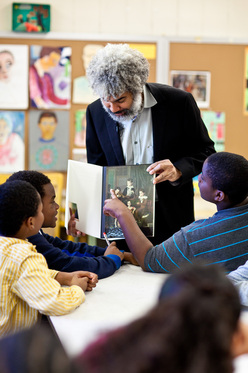 Fred Wilson with fifth-graders from PS 46 in Manhattan
Fred Wilson with fifth-graders from PS 46 in Manhattan "Teachers here want the program, parents want it, and students want it," Young told Wilson. The fifth-grade art students in Studio artist Robin Holder's art class were certainly excited to welcome guest artist Wilson and to learn that he had spent his childhood in the Bronx, only one subway stop away from this East Harlem school. Holder, who has worked at PS 46 since the late 1990s, predicted that her students would have "a wonderful adventure" with their visiting artist, and Wilson then led them on a journey into art, history and their own personal stories.
Fred Wilson describes himself as someone who likes to "look at things and decide to let the things I see tell the stories for me." One picture, which Wilson titled "The Conversation," showed a seated baby doll and a much smaller salt shaker in the shape of a maid. "What's the relationship?" Holder asked the children. One student suggested, "The baby is getting more attention from the artist, is more important." Wilson liked the answer: "That's a reversal of reality, right? Why? Maybe the baby has some power over this person because the baby's parents hired the maid; in our society, it's not how big you are that's important but how much power you have."
Wilson next showed a work from a museum show he did at the Maryland Historical Society, entitled "Mining the Museum, An Installation." "I come into a museum and objects talk to me," Wilson explained. He showed a picture of a painting that had been hanging in the museum since the 19th century, depicting five affluent-looking white children and two African-American children on the edges of the painting, so dark that they almost disappear into the background. The label mentions only the five white children. "Why not the black children?" Wilson asked. "That painting hung for more than 100 years and no one saw those children. Why? What was going on?" The class talked about slavery and the fact that those two children weren't "important enough" to get their names on the painting, or their faces made visible. When Holder asked the students why Wilson might be so interested in a painting that was 150 years old, a student answered, "Because he's the same race and everyone deserves the same attention and equality."
"I heard voices coming from the painting," said Wilson, "of children reacting to this. So I recorded audio reactions from a group of children who imagined what those children might be saying and included those voices in the installation. They asked things like, 'Where's my mother?' and 'Who washed my back?'" Wilson also showed the students the cover of his museum show catalog, where he had made paper cutouts revealing the two African-American children and covering up the white children. "I try to make things pop out that you don't see," Wilson said. "Mining means digging -- and blowing things up."
Wilson finished his presentation by "mining" the PS 46 art room, choosing objects that the children had made, combining them with other objects and inviting the children to share new perspectives and stories. "You want other people to see your perspective, you want people to look and see a story," Wilson said. "Everyone sees differently, it's not a story book, but you make people look and stop and think."
One girl volunteered a painful personal story that Wilson's art had inspired her to share -- about being bullied by a sibling who told her she looked disgusting. "I like the way I look," she said, "but my sister doesn't care about me." Holder asked the girl to stand up: "Isn't she beautiful?!" she asked the class and everyone applauded. A classmate said, "You should love yourself and be motivated to look like you want. Mr. Wilson is telling us that art gives you a voice." Wilson responded, "That's why I started making art. It made me feel good about myself. And I wanted to show other people that something is wrong. Art comes from a truth you know deep inside of you."
The fifth graders at PS 46 seemed wise beyond their years and clearly appreciated Wilson's art. "Do you want to try to heal the world?" one 11-year-old asked him. "I try to reveal things that people have been doing wrong," Wilson replied. The student responded: "You've been doing good with that."














 RSS Feed
RSS Feed
